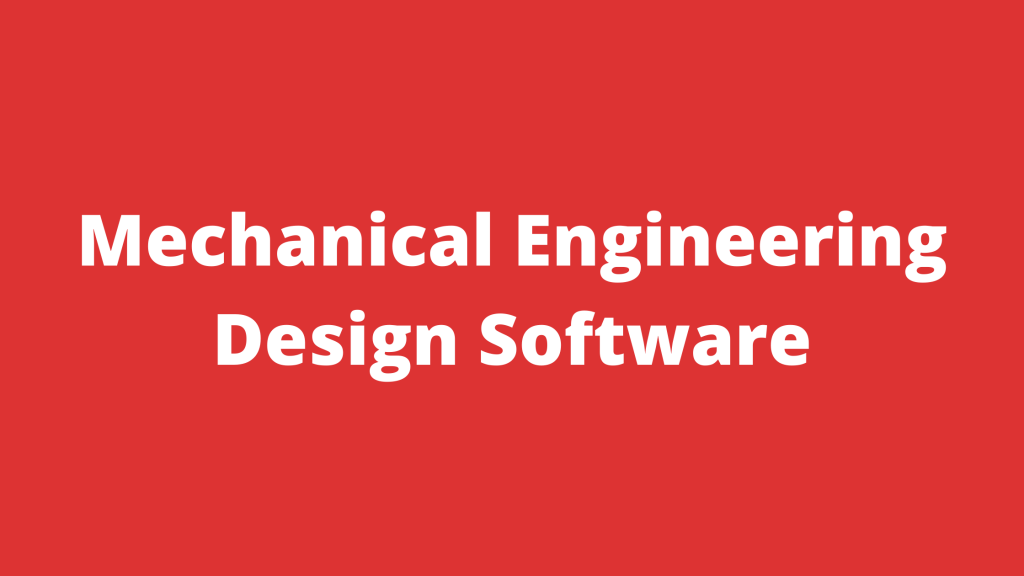3D modeling software is now an essential tool in a variety of industries. Engineers and designers are really making the most of these advanced software tools, which are helpful for a range of applications from simulation to manufacturing.
We have already made a selection of CAD software for a variety of applications on the blog. In this blog post, we are going to focus on the best design software that will help you shape your technical parts for mechanical engineering projects.
We will also look at all the benefits of 3D visualization and 3D printing for mechanical engineering projects. Follow the guide!

The Advantages of 3D Printing in Your Projects
3D printing is a wonderful manufacturing method for both production and prototyping. 3D printing for mechanical engineering projects will allow you to perform many modifications and iterations very quickly and at a low cost, which is very convenient for a prototyping process.
In fact, all you need to do is use 3D modeling software and make all the necessary modifications to improve your 3D model step by step. Using mechanical engineering software allows you to work directly on production.
You can even use different materials to design really complex parts. You can also use metal 3D printing as it will enable you to create really precise, heat-resistant, and well-designed parts. It is used, for example, in the automotive industry, but also for aeronautics and aerospace.
Your company has a lot to offer in additive manufacturing. To do this, modeling and simulating are essential, and you will need 3D CAD software with advanced features.
3D visualization: An essential tool
Some 3D software solutions have amazing rendering tools. Using visualization software or 3D modeling software with great visualization options can help you better understand your project.
In fact, getting a good and accurate overview of a technical project prior to the manufacturing process will allow you to adjust and improve your parts efficiently. It’s also a good way to correct past errors that you might have missed while designing 3D.
You must determine the best method for designing a concept and presenting it to your customers. 3D visualization is definitely the best way you can find! You can easily modify your model with your own views and customer’s input.
If you’ve been working on mechanical projects, you certainly know that design and analysis are essential. As a result, we recommend that you use software with strong analysis capabilities or another software tool that is entirely dedicated to simulation and analysis, such as ANSYS.
Best 3D modeling software for mechanical engineering
1. Unigraphics NX
UG (UnigraphicsNX) is a product engineering solution manufactured by Siemens PLM software, which provides users with digital modeling and validation methods for product design and processing.
Unigraphics Nx provides a proven solution for users’ virtual product design and process design requirements.
There is also an abbreviation for UG User Guide and Universal Grammar; It is also called Specter in DOTA.
The development of UG began in 1969 and was developed and implemented based on the C language.
UG NX is a flexible numerical software tool for solving partial differential equations developed using adaptive multigrid methods on two- and three-dimensional unstructured grids.
UG is an interactive CAD/CAM (Computer-Aided Manufacturing and Computer-Aided Design) system.
It has powerful functions and can easily realize the creation of various complex entities and shapes.
But with the development of PC hardware and the rapid development of individual users, applications on PC have achieved rapid development and become a mainstream application of 3D design in the die industry.
Industrial designers can use NX for modelling to quickly create and improve complex product shapes, as well as use advanced rendering and visualisation tools to maximise the aesthetic requirements of a design concept.
2. Computer-Aided Design (CAD) Software
Computer-aided design (CAD) software allows the creation of 3D models of parts and assemblies. CAD software has a drafting component that will enable you to create 2D drawings of your parts that can be manufactured.
CAD tools have direct integration into the FEA (Finite Element Analysis) package so that you can iterate between design and analysis seamlessly.
Examples of 3D CAD software: Unigraphics NX, CATIA, SolidWorks, and Autodesk Inventor.
3. Finite Element Analysis (FEA) Software
Structural analysis can be done with Finite Element Analysis (FEA). Finite element analysis software allows you to analyze stresses and deflections in complex structures.
A structure is usually drawn in a 3D CAD program, its geometry is created, a mesh is created to divide the structure into elements, forces and constraints are applied, and then the model is solved.
From the solved model, you can interrogate the tension and deflection in the structure.
Examples: NASTRAN and ANSYS.
4. ProE
ProE (PTC Creo or Creo Parametric) is developed by Parametric Technology Corporation and is an engineering design software tool.
It is 3D CAD software that provides assembly modeling, finite element analysis, NURBS surface modeling, and great features dedicated to mechanical designers.
It is a good and complete software solution for your mechanical parts to do rapid prototyping and produce your end-use products.
5. Mathematica
Mathematica is a technological computing system that could allow you to completely fabricate solid parts for your future 3D printed mechanical parts.
It provides advanced features like 2D and 3D data visualization, functions and geo-visualization, and animation tools.
This program is particularly convenient for any scientific, mathematical, or engineering project if you want to start your own 3D modeling project using Mathematica.
6. SolidWorks
Solidworks is a native 3D design software based on Windows systems.
SolidWorks’ user-friendly interface allows it to fully automatically capture design intent and guide design changes throughout product design work.
In Solidworks’ assembly design, it can directly reference existing parts to generate new parts. Solidworks’ easy-to-use operation will greatly improve design efficiency regardless of whether the design uses a “top-down” method or a “bottom-up” method for assembly design.
Not only do users use SolidWorks software to solve common part design problems, but more and more users are starting to use SolidWorks software to handle system-level large-scale assembly design.
The speed of uploading large assemblies is becoming more and more.
Faced with the needs of users, SolidWorks’ R&D department has managed to improve the upload speed of large assemblies from various angles, including the use of graphics compression technology and distributed data processing, which has improved the performance of large assemblies ten times.
7. TurboCAD Deluxe
This mechanical engineering software offers many different features. It has a steep learning curve, but at the same time, it is quite powerful. You’ll be able to work in both 2D and 3D, customize UIs, and use simulated mechanical tools for engineering projects.
Rendering options, such as different materials and lighting, will also be useful to product designers. They will be able to create photorealistic visuals.
You will also be able to easily share your work with other 3D software, such as SketchUp or AutoCAD. Plus, your 3D models can be prepared for 3D printing with TurboCAD Deluxe.
8. AutoCAD Mechanical
Autodesk creates 3D modelling classics, and AutoCAD is unquestionably one of them. As mechanical engineering 3D software evolves, so does this program.
Autodesk created a version that combines the reliable tools and functionality of AutoCAD with customized mechanical tools: AutoCAD Mechanical. This 3D program allows you to document CAD models, reuse mechanical drawing detailing tools but also create rectangles from ribbons, restore and separate layer groups, and much more.
Most importantly, AutoCAD Mechanical will provide you with a huge library (over 700 000) of standard parts and support for international drafting standards. It is a true game-changer in the world of mechanical engineering.
9. FreeCAD
This 3D modelling software is similar to SolidWorks, but it is free and open-source. Driven by users’ needs, FreeCAD offers a wide range of tools for mechanical engineering and product design applications.
FreeCAD is a parametric 3D software that will allow you to edit a model’s history by going through it easily.
It is an excellent software for beginners but will still provide professional-grade options to advanced CAD users.
10. SolveSpace
Solvespace is another 2D/3D parametric software. It is a great 3D program for creating CAM data, design mechanisms, use planes, and solid geometry.
Key features of SolveSpace include constraints on distances and dimensions, approximate distances, lengths in imperial and metric units, and various sketch tools. You can also analyze your model. Above all, you can prepare your projects for 3D printing.
11. DesignSpark Mechanical
This 3D modeling software is a free 3D program that enables mechanical engineers and manufacturers to produce rapid prototyping and reverse engineering projects thanks to a wide range of tools.
DesignSpark Mechanical will integrate seamlessly into your current workflow. Work through the entire design process, from sketch, rapid prototyping to final production. You’ll also be able to prepare your projects for 3D printing.
Useful Tip: If you are looking for a career in the core mechanical field, you should at least practice designing on some mechanical engineering software.




